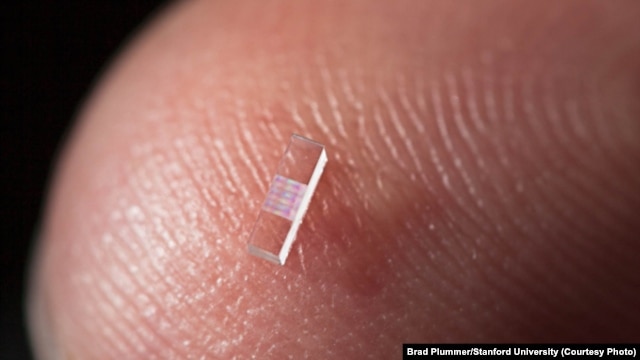
Particle accelerator on a nanostructured glass chip is smaller than a grain of rice. (Brad Plummer/Stanford University)
When many think about a particle accelerator device, they may think of units such as CERN’s Large Hadron Collider (LHC) in Switzerland. The LHC is enormous - a tunnel 27 kilometers in circumference sitting 175 meters underground. Writing in Nature, the researchers said they used a laser rather than microwaves to accelerate electrons in a nanostructured glass chip smaller than a grain of rice. The scientists said they were able speed up those electrons at a rate 10 times higher than its possible using current conventional technology. "We still have a number of challenges before this technology becomes practical for real-world use, but eventually it would substantially reduce the size and cost of future high-energy particle collidersfor exploring the world of fundamental particles and forces," said Joel England, the SLAC physicist who led the experiments. The findings could lead to miniature, compact accelerators as well x-ray devices that could be used in a variety of applications such as security scanning, medical imaging for hospitals, materials science and biology research. The innovation could also lead to medical treatment such as particle therapy that uses accelerated protons, neutrons, or positive ions to treat cancer or improve medical care for people injured in combat. Not only would the new micro-accelerators be a lot smaller is size, said the scientists, the technology could also be cost effective since commercial lasers could be used and low-cost, mass-production techniques could be employed in building the units. The researchers think their findings could make way for new generations of "tabletop accelerators.” However, the researchers have some fundamental issues they need to address first.
 The SLAC National Accelerator Laboratory's linear particle accelerator consists of 3.22 kilometers of copper cavities. (SLAC National Accelerator Laboratory)
The SLAC National Accelerator Laboratory's linear particle accelerator consists of 3.22 kilometers of copper cavities. (SLAC National Accelerator Laboratory) In order to create a real tabletop accelerator, the scientists say they will first need to come up with a much more compact device to get those electrons up to light-speed before they enter a small accelerator.
To conduct their “accelerator-on-a-chip” experiments, the scientists first had to speed up electrons to near thespeed of light by using a conventional accelerator such as SLAC's 3.22 kilometer-long linear accelerator in California. After getting up to light-speed, the electrons were then focused into a tiny channel within a glass chip that’s only about a half-micron-high and a half millimeter long in size.
By Rick Pantaleo
Source: http://www.voanews.com/content/new-research-could-lead-to-particle-accelerator-on-a-chip/1760104.html?utm_content=wall-post&utm_campaign=en&utm_source=voice-of-america&utm_medium=facebook
No comments:
Post a Comment